Netty的学习
看了几天高并发和NIO 今晚终于要开始学习Netty
http://ifeve.com/netty5-user-guide/
Netty实现通信的步骤
1.创建两个NIO线程组,一个专门用于网络事件的处理(接收客户端的连接), 另一个则进行网络通信读写
2.创建一个ServerBootStarp对象,配置Netty的一些列参数,例如接受传出数据内存的大小等。
3.创建一个世纪处理数据的类ChannelInitializer,进行初始化的工作,例如设置接收传出数据的字符集·格式·已经实现处理数据的接口
4.绑定端口,执行同步阻塞方法等待服务端的启动
TCP粘包拆包
TCP是一个流的协议,数据没有分界线 如果传了三个包 ABC DEF GHI TCP会根据缓冲区实际情况进行包的划分就容易 解读为 AB CDEF GHI
解决办法:1.消息定长,例如每个报文大小固定为200,如果不够,空位补空格
2.在包尾加特殊字符进行分割
3.将消息分为消息头和消息体,在消息头中包含消息总长度的字段,然后进行业务逻辑的处理
public class Server { public static void main(String[] args) throws Exception { //1 创建线两个程组 //一个是用于处理服务器端接收客户端连接的 //一个是进行网络通信的(网络读写的) EventLoopGroup pGroup = new NioEventLoopGroup(); EventLoopGroup cGroup = new NioEventLoopGroup(); //2 创建辅助工具类,用于服务器通道的一系列配置 ServerBootstrap b = new ServerBootstrap(); b.group(pGroup, cGroup) //绑定俩个线程组 .channel(NioServerSocketChannel.class) //指定NIO的模式 .option(ChannelOption.SO_BACKLOG, 1024) //设置tcp缓冲区 .option(ChannelOption.SO_SNDBUF, 32*1024) //设置发送缓冲大小 .option(ChannelOption.SO_RCVBUF, 32*1024) //这是接收缓冲大小 .option(ChannelOption.SO_KEEPALIVE, true) //保持连接 .childHandler(new ChannelInitializer<SocketChannel>() { @Override protected void initChannel(SocketChannel sc) throws Exception { //3 在这里配置具体数据接收方法的处理 sc.pipeline().addLast(new ServerHandler()); } }); //4 进行绑定 ChannelFuture cf1 = b.bind(8765).sync(); //ChannelFuture cf2 = b.bind(8764).sync(); //5 等待关闭 cf1.channel().closeFuture().sync(); //cf2.channel().closeFuture().sync(); pGroup.shutdownGracefully(); cGroup.shutdownGracefully(); } }
public class ServerHandler extends ChannelHandlerAdapter { @Override public void channelActive(ChannelHandlerContext ctx) throws Exception { System.out.println("server channel active... "); } @Override public void channelRead(ChannelHandlerContext ctx, Object msg) throws Exception { ByteBuf buf = (ByteBuf) msg; byte[] req = new byte[buf.readableBytes()]; buf.readBytes(req); String body = new String(req, "utf-8"); System.out.println("Server :" + body ); String response = "进行返回给客户端的响应:" + body ; ctx.writeAndFlush(Unpooled.copiedBuffer(response.getBytes())) .addListener(new ChannelFutureListener() { @Override public void operationComplete(ChannelFuture future) throws Exception { if (future.isSuccess()) { System.out.println("write is success"); } else { future.cause().printStackTrace(); } } }) .addListener(ChannelFutureListener.CLOSE); // 关闭 } @Override public void channelReadComplete(ChannelHandlerContext ctx) throws Exception { System.out.println("读完了"); ctx.flush(); } @Override public void exceptionCaught(ChannelHandlerContext ctx, Throwable t) throws Exception { ctx.close(); } }
public class Client { public static void main(String[] args) throws Exception{ EventLoopGroup group = new NioEventLoopGroup(); Bootstrap b = new Bootstrap(); b.group(group) .channel(NioSocketChannel.class) .handler(new ChannelInitializer<SocketChannel>() { @Override protected void initChannel(SocketChannel sc) throws Exception { sc.pipeline().addLast(new ClientHandler()); } }); ChannelFuture cf1 = b.connect("127.0.0.1", 8765).sync();
//这个对象可以看作是一个异步操
//作的结果的占位符;它将在未来的某个时刻完成,并提供对其结果的访问
//ChannelFuture cf2 = b.connect("127.0.0.1", 8764).sync(); //发送消息 Thread.sleep(1000); cf1.channel().writeAndFlush(Unpooled.copiedBuffer("777".getBytes())); cf1.channel().writeAndFlush(Unpooled.copiedBuffer("666".getBytes())); //cf2.channel().writeAndFlush(Unpooled.copiedBuffer("888".getBytes())); Thread.sleep(2000); cf1.channel().writeAndFlush(Unpooled.copiedBuffer("888".getBytes())); //cf2.channel().writeAndFlush(Unpooled.copiedBuffer("666".getBytes())); cf1.channel().closeFuture().sync(); //cf2.channel().closeFuture().sync(); group.shutdownGracefully(); } }
public class ClientHandler extends ChannelHandlerAdapter{ @Override public void channelActive(ChannelHandlerContext ctx) throws Exception { } @Override public void channelRead(ChannelHandlerContext ctx, Object msg) throws Exception { try { ByteBuf buf = (ByteBuf) msg; byte[] req = new byte[buf.readableBytes()]; buf.readBytes(req); String body = new String(req, "utf-8"); System.out.println("Client :" + body ); String response = "收到服务器端的返回信息:" + body; } finally { ReferenceCountUtil.release(msg); } } @Override public void channelReadComplete(ChannelHandlerContext ctx) throws Exception { } @Override public void exceptionCaught(ChannelHandlerContext ctx, Throwable cause) throws Exception { ctx.close(); } }
这里面的Bootstarp 相当于配置引导类
对于 ChannelInitializer 是ChannelHandler Netty 程序都是基于 ChannelPipeline。ChannelPipeline 和 EventLoop 和EventLoopGroup 密切相关,因为它们三个都和事件处理相关,所以这就是为什么它们处理IO 的工作由 EventLoop 管理的原因
当注册一个Channel后 Netty 将这个 Channel 绑定到一个 EventLoop,在 Channel 的生 命周期内总是被绑定到一个 EventLoop。在 Netty IO 操作中,你的程序不需要同步,因为
一个指定通道的所有 IO 始终由同一个线程来执行
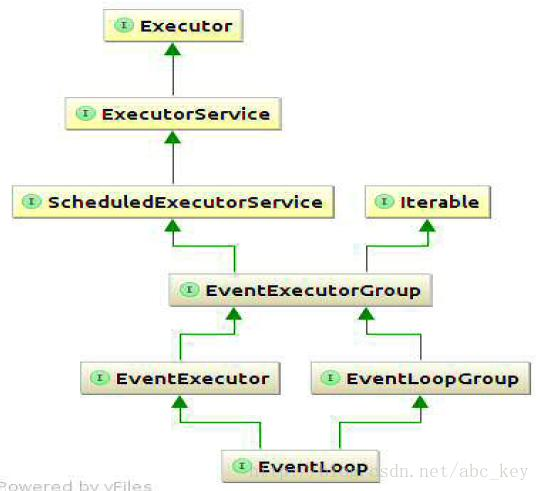
ServerBootstrap 使用 2 个 EventLoopGroup
一个 ServerBootstrap 可以认为有 2个 channels 组,
第一组包含一个单例 ServerChannel,代表持有一个绑定了本地端口的socket;
第二组包含所有的 Channel,代表服务器已接受了的连接

EventLoopGroup A 唯一的目的就是接受连接然后交给 EventLoopGroup B,
//1 创建线两个程组
//一个是用于处理服务器端接收客户端连接的
//一个是进行网络通信的(网络读写的)
Netty可以使用两个不同的 Group,因为服务器程序需要接受很多客户端连接的情况下,一个EventLoopGroup 将是程序性能的瓶颈,因为事件循环忙于处理连接请求,没有多余的资源
和空闲来处理业务逻辑,最后的结果会是很多连接请求超时。若有两 EventLoops, 即使在高负载下,所有的连接也都会被接受,因为 EventLoops 接受连接不会和哪些已经连接了的处理共享资源
EventLoopGroup 和 EventLoop 是什么关系?EventLoopGroup 可以包含很多个EventLoop,每个 Channel 绑定一个 EventLoop 不会被改变,因为 EventLoopGroup 包含少量的 EventLoop 的 Channels,很多 Channel 会共享同一个 EventLoop。这意味着在一个Channel 保持 EventLoop 繁忙会禁止其他 Channel 绑定到相同的 EventLoop。我们可以理解为 EventLoop 是一个事件循环线程,而 EventLoopGroup 是一个事件循环集合。
ChannelFuture
这个对象可以看作是一个异步操作的结果的占位符;它将在未来的某个时刻完成,并提供对其结果的访问
每个 Netty 的出站 I/O 操作都将返回一个 ChannelFuture;也就是说,它们都不会阻塞。正如我们前面所提到过的一样,Netty 完全是异步和事件驱动的
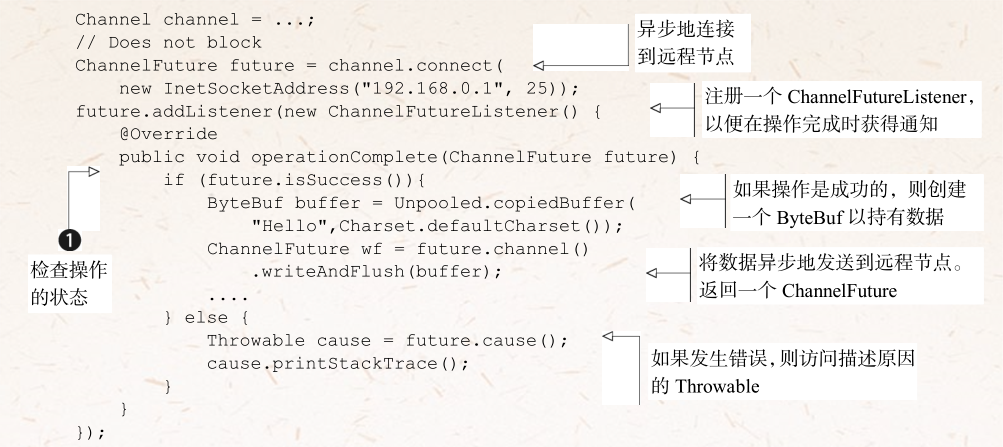
Netty 中发送消息有两种方法:直接写入通道或写入ChannelHandlerContext 对象。这两种方法的主要区别如下:
直接写入通道导致处理消息从 ChannelPipeline 的尾部开始(ChannelOutboundHandler 出站)
写入 ChannelHandlerContext 对象导致处理消息从 ChannelPipeline 的下一个handler 开始(ChannelInboundHandler入站)
对于这些Handler 常 有“ByteToMessageDecoder”、“MessageToByteEncoder”,还有 Google 的协议“ProtobufEncoder”和“ProtobufDecoder”
我们可以在添加 ChannelHandler 到 ChannelPipeline 中时指定一个 EventExecutorGroup,EventExecutorGroup 会获得一个 EventExecutor,EventExecutor将执行ChannelHandler 的所有方法。EventExecutor 将使用不同的线程来执行和释放EventLoop
Transport API
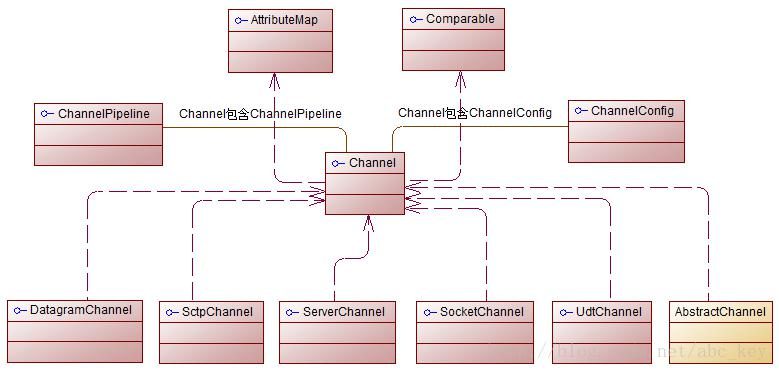
如上图所示,每个 Channel 都会分配一个 ChannelPipeline 和 ChannelConfig
ChannelConfig 负责设置并存储配置,并允许在运行期间更新它们, ChannelPipeline 容纳了使用的 ChannelHandler 实例
ChannelHandler
传输数据时,将数据从一种格式转换到另一种格式
异常通知
Channel 变为有效或无效时获得通知
Channel 被注册或从 EventLoop 中注销时获得通知
通知用户特定事件
Channel
eventLoop(),返回分配给 Channel 的 EventLoop
pipeline(),返回分配给 Channel 的 ChannelPipeline
isActive(),返回 Channel 是否激活,已激活说明与远程连接对等
localAddress(),返回已绑定的本地 SocketAddress
remoteAddress(),返回已绑定的远程 SocketAddress
write(),写数据到远程客户端,数据通过 ChannelPipeline 传输过去
不同类型的 ByteBuf
Heap Buffer(堆缓冲区)
存储在JVM的堆上,存储在数组中,清除也很快 ByteBuf.array()获取数据 hasArray 检查
Direct Buffer(直接缓冲区)
直接缓冲区,在堆之外直接分配内存。直接缓冲区不会占用堆空间容量。直接缓冲区在使用 Socket 传递数据时性能很好,因为若使用间接缓冲区,JVM 会先将数据复制到直接缓冲区再进行传递;缺点是在分配内存空间和释放内存时比堆缓冲区更复杂,而 Netty 使用内存池来解决这样的问题,这也是 Netty 使用内存池的原因之一。直接缓冲区不支持数组访问数据,但是我们可以间接的访问数据数组
ByteBuf directBuf = Unpooled.directBuffer(16); if(!directBuf.hasArray()){ int len = directBuf.readableBytes(); byte[] arr = new byte[len]; directBuf.getBytes(0, arr); }
Composite Buffer(复合缓冲区)
CompositeByteBuf compBuf = Unpooled.compositeBuffer(); ByteBuf heapBuf = Unpooled.buffer(8); ByteBuf directBuf = Unpooled.directBuffer(16); // 添加 ByteBuf 到 CompositeByteBuf compBuf.addComponents(heapBuf, directBuf); // 删除第一个 ByteBuf compBuf.removeComponent(0); Iterator<ByteBuf> iter = compBuf.iterator(); while (iter.hasNext()) { System.out.println(iter.next().toString()); } // 使用数组访问数据 if (!compBuf.hasArray()) { int len = compBuf.readableBytes(); byte[] arr = new byte[len]; compBuf.getBytes(0, arr); }
ByteBuf 提供两个指针变量支付读和写操作,读操作是使用 readerIndex(),写操作时使用 writerIndex()。这和 JDK 的 ByteBuffer 不同,ByteBuffer 只有一个方法来设置索引所以需要使用 flip()方法来切换读和写模式
discardReadBytes()可以用来清空 ByteBuf 中已读取的数据,
isReadable() 判断 writerIndex > readerIndex;
writableBytes capacity() - writerIndex 能否写
clear() 重设索引 readerIndex = writerIndex = 0;
调用 duplicate()、slice()、slice(int index, int length)、order(ByteOrder endianness)
会创建一个现有缓冲区的视图
ByteBufAllocator 负责分配 ByteBuf 实例 ByteBufAllocator.heapBuffer()
可以从 Channel 的 alloc()获取,也可以从ChannelHandlerContext 的 alloc()获取
Unpooled 也能创建ByteBuf实例 Unpooled.compositeBuffer(); Unpooled.buffer(8);
ChannelHandler
ChannelPipeline
ChannelPipeline是ChannelHandler实例的列表,用于处理或截获通道的接收和发送数据。
addFirst(...),添加ChannelHandler在ChannelPipeline的第一个位置 addBefore(...),在ChannelPipeline中指定的ChannelHandler名称之前添加ChannelHandler
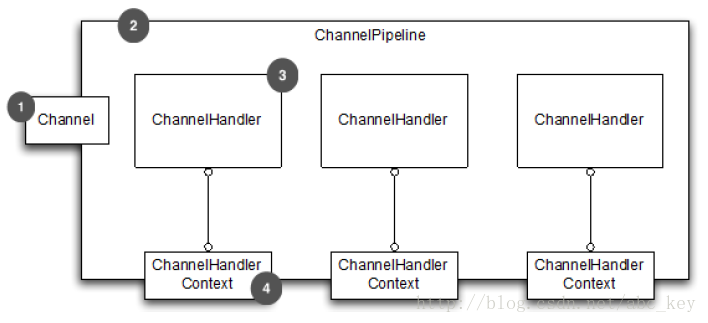
每个ChannelHandler被添加到ChannelPipeline后,都会创建一个ChannelHandlerContext并与之创建的ChannelHandler关联绑定。ChannelHandlerContext允许ChannelHandler与其他的ChannelHandler实现进行交互。
- 调用Channel的方法
- 调用ChannelPipeline的方法
@Override protected void initChannel(SocketChannel ch) throws Exception { ch.pipeline().addLast(new ChannelInboundHandlerAdapter() { @Override public void channelActive(ChannelHandlerContext ctx) throws Exception { //Event via Channel Channel channel = ctx.channel(); channel.write(Unpooled.copiedBuffer("netty in action", CharsetUtil.UTF_8)); //Event via ChannelPipeline ChannelPipeline pipeline = ctx.pipeline(); pipeline.write(Unpooled.copiedBuffer("netty in action", CharsetUtil.UTF_8));
//为了节省开销,不感兴趣的ChannelHandler不让通过 直接跳过前面
//排除一些ChannelHandler
ctx.write(Unpooled.copiedBuffer("Netty in Action", CharsetUtil.UTF_8));
}
});
}
ChannelHandler实例如果带有@Sharable注解则可以被添加到多个ChannelPipeline。也就是说单个ChannelHandler实例可以有多个ChannelHandlerContext,因此可以调用不同ChannelHandlerContext获取同一个ChannelHandler
Channel的状态在其生命周期中变化
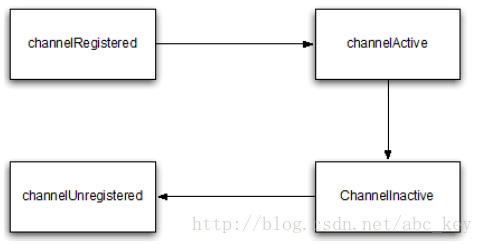
- handlerAdded,ChannelHandler添加到实际上下文中准备处理事件
- handlerRemoved,将ChannelHandler从实际上下文中删除,不再处理事件
- exceptionCaught,处理抛出的异常
ChannelInboundHandler\
- channelRegistered,ChannelHandlerContext的Channel被注册到EventLoop;
- channelUnregistered,ChannelHandlerContext的Channel从EventLoop中注销
- channelActive,ChannelHandlerContext的Channel已激活
- channelInactive,ChannelHanderContxt的Channel结束生命周期
- channelRead,从当前Channel的对端读取消息
- channelReadComplete,消息读取完成后执行
- userEventTriggered,一个用户事件被处罚
- channelWritabilityChanged,改变通道的可写状态,可以使用Channel.isWritable()检查
- exceptionCaught,重写父类ChannelHandler的方法,处理异常
常用的 SimpleChannelInboundHandler
ChannelOutboundHandler
- bind,Channel绑定本地地址
- connect,Channel连接操作
- disconnect,Channel断开连接
- close,关闭Channel
- deregister,注销Channel
- read,读取消息,实际是截获ChannelHandlerContext.read()
- write,写操作,实际是通过ChannelPipeline写消息,Channel.flush()属性到实际通道
- flush,刷新消息到通道
ByteToMessageDecoder
MessageToByteEncoder
ByteToMessageCodec 用来处理 byte-to-message 和 message-to-byte
MessageToMessageCodec
CombinedChannelDuplexHandler 来结合解码器和编码器 组合



